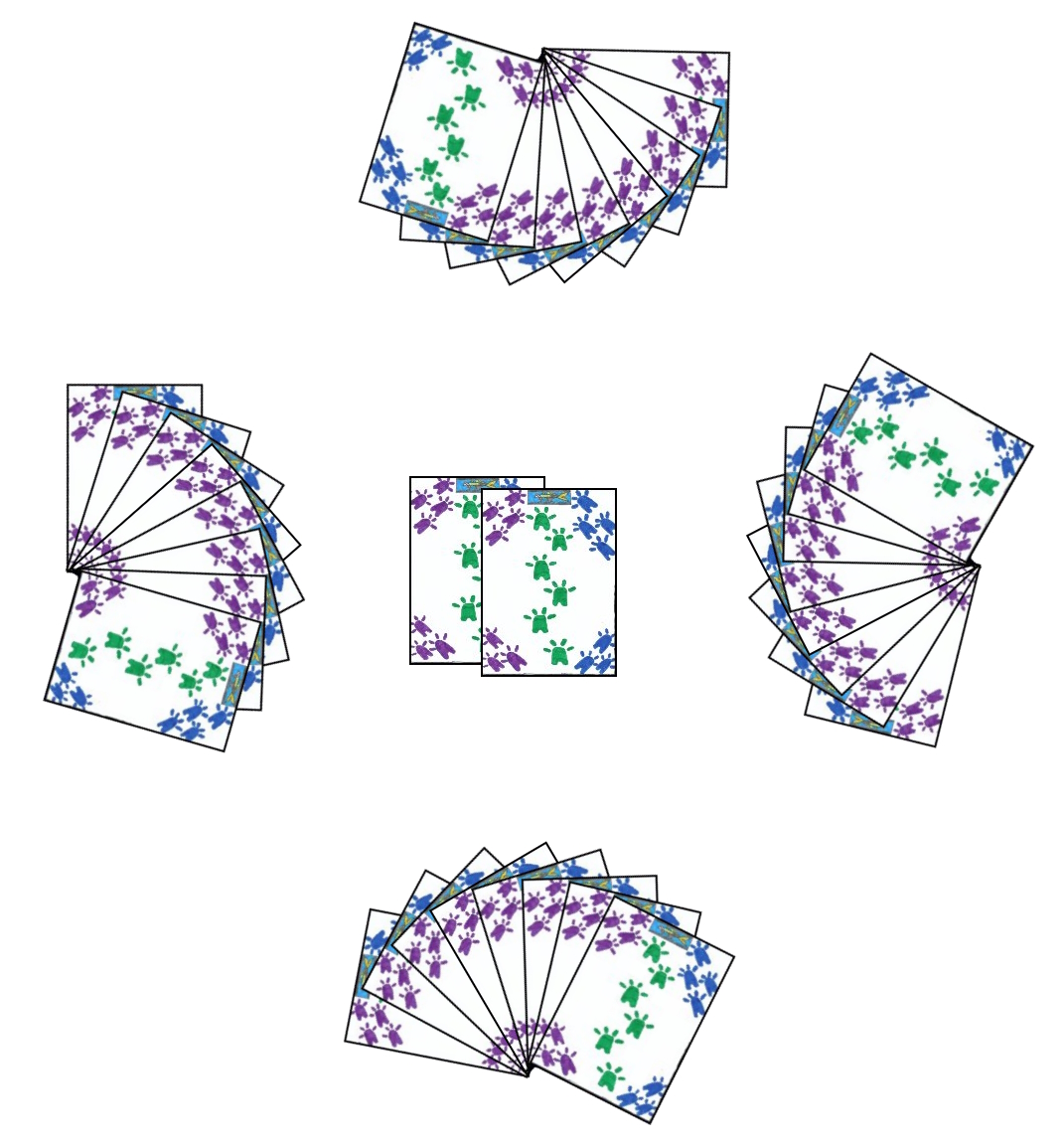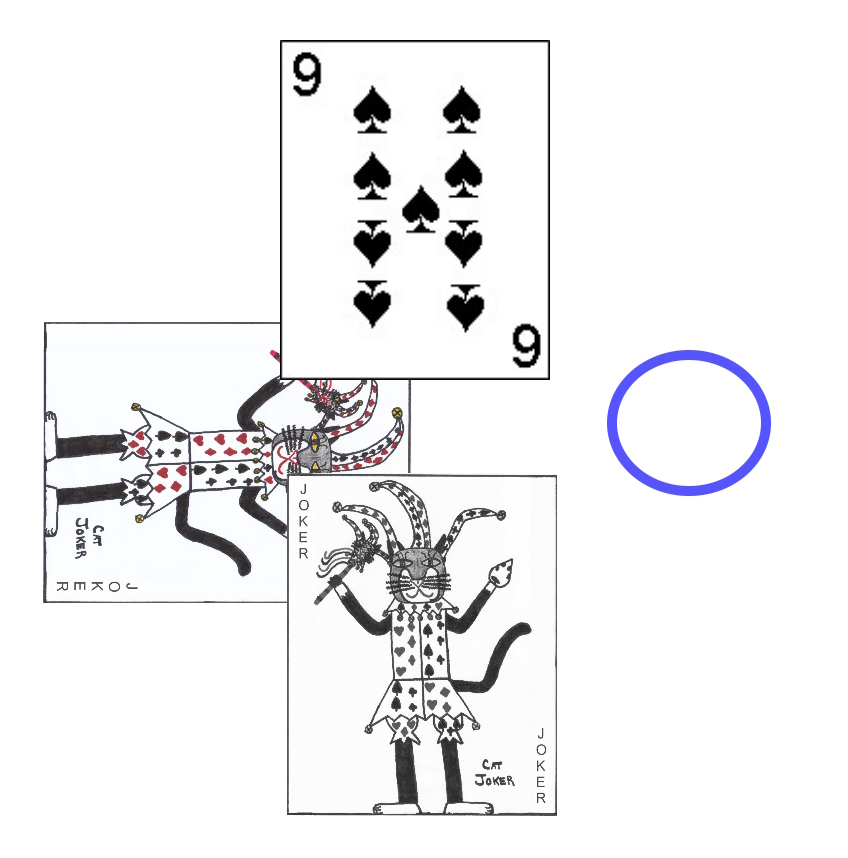Charlemagne is a trick taking game that is popular in many areas of Eastern Canada as well as in some of the neighboring states of the United States, such as Maine. Charlemagne is a trick taking game with some similarities to Euchre, including the ranking of the Jacks. The game is designed for play by four players, playing in two partnerships consisting of two players each.
The deck used in the play of this game is one standard deck which has been reduced to 32 cards (by removing all cards of lower rank than 7) and adding two Jokers, resulting in a 34 card deck as used for the game. The two Jokers added to the deck should be distinguishable from each other in some manner as one Joker is ranked higher than the other. By tradition, in decks in which the Jokers are so distinguishable, the black and white Joker is considered higher than the color Joker.
The ranking of the cards is dependent on specifically which suit has been set as the trump suit for the hand:
- In the designated trump suit for the hand, the cards rank in the following order (from highest to lowest); Black and White Joker, Color Joker, Jack of the trump suit, Jack of same color but different suit as the trump suit, Ace of trump suit, King of trump suit, Queen of trump suit, 10 of trump suit, 9 of trump suit, 8 of trump suit, 7 of trump suit.
- In the other suit of the same color as the trump suit, the ranking of the cards in that suit is as follows (highest to lowest); Ace, King, Queen, 10, 9, 8, 7.
- In the two remaining suits (of a different color than the trump suit), the ranking of the cards is as follows (from highest to lowest); Ace, King, Queen, Jack, 10, 9, 8, 7.

 After the players are seated the dealer should thoroughly shuffle the cards and the player at his immediate right then has the option to cut the deck. After the cut, the dealer then begins the deal, dealing the cards face-down to the players in a clockwise direction, starting with the player at his left. The cards are dealt in packets of two cards, continuing in rotation until each player has a total of eight cards. After each player has the requisite number of cards, the dealer then deals the last two cards face-down to the center of the table as the kitty.
After the players are seated the dealer should thoroughly shuffle the cards and the player at his immediate right then has the option to cut the deck. After the cut, the dealer then begins the deal, dealing the cards face-down to the players in a clockwise direction, starting with the player at his left. The cards are dealt in packets of two cards, continuing in rotation until each player has a total of eight cards. After each player has the requisite number of cards, the dealer then deals the last two cards face-down to the center of the table as the kitty.
Once the dealing procedure has been completed, a single round of bidding occurs. The player to the immediate left of the dealer has the first opportunity to bid. Each player must pass or name a bid which is higher than any previously made bid. The following are the possible bids, shown from lowest to highest such bid:
- Five - This is the lowest bid, and is a bid by a player indicating the intention of he and his partner winning five or more tricks during the hand.
- Six - This is a bid indicating that the player intends for he and his partner to win six or more tricks during this hand.
- Seven - This bid indicates the intention of the player and his partner to win a minimum of seven tricks during the hand.
- Eight - This is a bid by the player obligating he and his partner to win every trick (all eight) in the hand.
- Mulot - This is a bid by a player indicating that he will play alone (without the aid of his partner) and without using the kitty, with the goal to win zero tricks during the hand.
- Charlemagne (Petit Charles) - This is a bid by the player indicating he will play alone, with the option to exchange cards with the kitty and the highest card from his partner.
- Gros Mulot - This is a bid by the player to play alone, however, he must place his entire hand, face-up on the table exposed to every player.
- Gros Charlemagne - This is the highest bid in the game, and is a bid for the player to play alone, and may exchange cards with the kitty or with the top card from his partner, but not both.
If the highest bid was a bid of "Five", "Six", "Seven", or "Eight", the high bidder adds the two cards from the kitty into his hand, and then, after examining the hand, discards any two cards form his hand aside, and out of play and then names his choice of trump suits at which the hand is to be played at. The player to the immediate left of the high bidder than leads the first card to the first trick.
If the highest bid was a bid of "Mulot" or "Gros Mulot", the partner of the high bidding player simply places his cards face-down on the table, and these cards as well as those from the kitty are set aside, and out of play. There is no declared trump suit, but the two Jokers still retain their ranking as the two highest cards in the deck. Thus, the ranking of the cards is as follows: Black and White Joker, Color Joker, Ace, King, Queen, Jack, 10, 9, 8, 7. If the bid was Gros Mulot the high bidder must also lay his entire hand face-up on the table for all players to see. The high bidder is entitled to lead the first card to the first trick.
If the highest bid was "Charlemagne" the high bidder takes the kitty into his hand and the partner of the bidder than is entitled to pass the high bidder any one card across the table to the high bidder. The high bidder than discards any three cards from his now enlarged hand to the table and sets them aside, out of play. The high bidders partner also sets the remainder of his hand aside out of play, and he takes no further part in that hand. The high bidder is entitled to lead the first card to the first trick immediately after declaring the trump suit to be used for that hand.
If the highest bid was "Gros Charlemagne" the high bidder has the option of either adding the two cards from the kitty into his hand, and discard two cards, or he may opt to not take the kitty and request a card from his partner. If he takes the kitty, he adds these cards to his hand, and then discards two cards from his hand aside and out of play. Instead if he opts for a card from his partner, the cards from the kitty are set aside, and his partner passes this player any one card of his choice from his hand. The high bidder add this card to his hand, and then discards any one card from his hand aside, and out of play. The partner also discards his cards aside and those cards and that player take no further part in that hand. After examining his hand, the high bidder than declares a trump suit of his choice and leads the first card to the first trick.
 |
| In a bid of Mulot or Gros Mulot, if one Joker is led to the trick, the player with the other Joker must play it to that same trick |
After each player has played one card to each trick it is determine who has managed to win the trick. The player of the highest card in the trump suit (if there is a trump suit) is considered the winner of the trick. If the trick contains no cards from the trump suit, the highest card of the suit originally led to that trick wins it. The cards from that trick are set aside out of play for the remainder of the hand. The leader of each tricks then leads the first card to the next trick.
The hand continues in this way until all eight tricks have been played and won, after which time it is determined if the bidder managed to make his contract and earns or loses points accordingly:
- In a bid of Five, Six, Seven, or Eight, if the bidding team manages to win at least as many tricks as bid, that partnership earns a number of points for the hand equal to the number bid (5, 6, 7, or 8). If they fail to win at least as many tricks as bid the opponents instead win a number of points equal to the amount of the bid.
- In a bid of Mulot, if the bidding player manages to win zero tricks during the hand, that player's partnership earns 15 points for the hand. However, if that player takes one or more tricks during the hand, the opponent's score 7 points for the hand.
- In a bid of Charlemagne, if the bidding player manages to win every trick, his partnership earns 16 points. If the bidder does not win every trick during the hand, the opposing team wins 8 points instead.
- In a bid of Gros Mulot, if the bidding player manages to lose every trick during the hand, his partnership earns a score of 30 points for the hand. However, if that player wins one or more tricks during the hand, the opponents score 15 points.
- In a bid of Gros Charlemagne, if the bidding player manages to win every trick during the hand, he and his partnership instantly win the entire game (32 points). However, if he fails to win one or more tricks during the hand, the opposing team scores 16 points.
